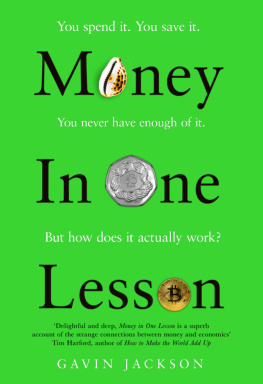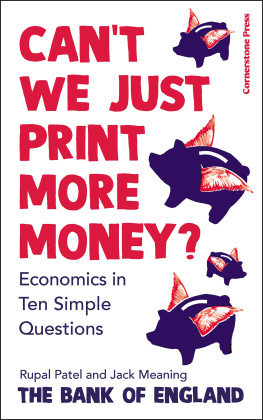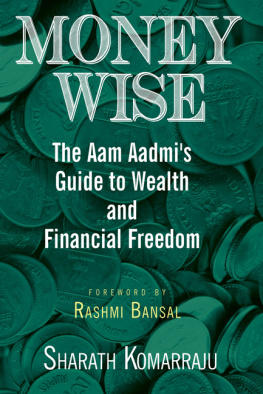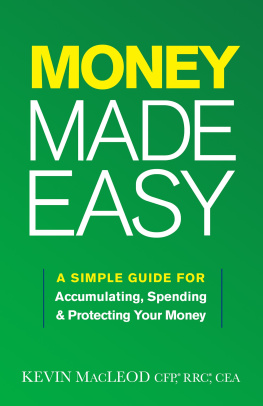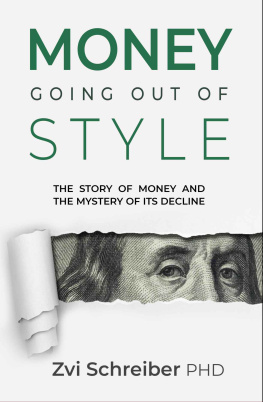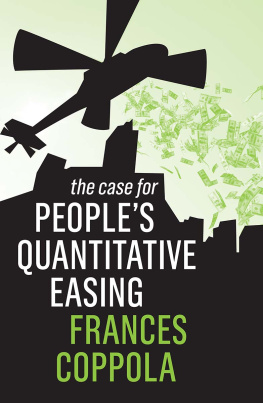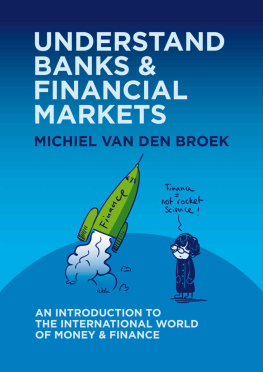Money in One Lesson
How It Works and Why
Gavin Jackson

Contents
For my father
Introduction
People have all sorts of strange ideas about money. Tradition has it that when you make a wish at the Trevi Fountain in Rome you must always toss a coin into the water over your left shoulder. Only if you follow this rule exactly are you guaranteed to return to the Eternal City. In Britain pushing a small coin into the bark of certain wishing trees is supposed to cure you of any illness although the practice often kills the tree. We learn as children that the Tooth Fairy will exchange any baby teeth we leave under our pillows for money.
There really is something magical about money. Despite only being a set of representative tokens although often decorated with obscure symbols and phrases in dead languages money can still build cathedrals, send us to space, or cause someone to sacrifice what they thought were their most valued principles. Few other things can have done so much to transform the world and our lives, despite being so inherently worthless.
Despite this magic, money comes with a fairly dry set of associations conjuring up visions of a miserly Ebenezer Scrooge-like figure in counting houses, stacking up his coins and ignoring the needs of his employees. Money is meant to signify calculation and rationality, indifference and impersonality. The world of money is supposed to be one of figures and facts, without any room for folklore and superstition. The mysteries of money are cloaked by technical, mathematical language obscuring the fact that, as this book will show, money is always deeply human and interpersonal.
It is partly this social nature that has meant economists have struggled to cope with money. The starting point of the discipline is often though not always individuals who make choices based on what is in their best interest, but there is nothing, on the surface, rational or self-interested about the ritual at the Trevi Fountain, or really anything about the way we invest money with symbolic value.
Money is communal rather than individual. It is a shared fiction; it is a story we believe in so long as others act as if it is true. As a headline in the satirical US newspaper TheOnion has it: US economy grinds to halt as nation realizes money just a symbolic, mutually shared illusion. Moneys power comes solely from the fact that we all treat that power as if it is really there. Insisting that seashells are money would not get you very far today, but there have been plenty of times when you would have been absolutely right. It is context that gives money its value.
Myths and folklore like the Tooth Fairy can therefore serve a deeper truth, or a purpose at least. In the words of one historian writing on the subject, money circulates among a faith-based community. Through these exchanges whether tossing coins in wishing wells or giving up our baby teeth we are reasserting and reaffirming moneys value. The superstitions reinforce the metaphor at the heart of money that the tokens are really worth something.
Money seems to have been getting stranger in recent years. Our faith in it has been shaken: the story we are telling is becoming surreal. When banks failed in the 2008 financial crisis, many of us took, maybe for the first time, a deeper look at money and wondered exactly what we were looking at. The economic chaos that followed called attention to banks role in our monetary system and how much we depend on them. Debt both public and private seemed to have proliferated without limit. Government money-printing policies known as quantitative easing caused us to question how money could keep its value when it could be created so easily at the touch of a button; and why, we asked, were governments so concerned to repay their debt if they faced only an artificial shortage of cash?
Technology, too, has called our attention to how money may not be all as it seems. What we thought it was metal coins and paper notes is disappearing and now we can pay just using our fingerprints, for example. Then there are new types of money appearing out of nowhere: cryptocurrencies that seem to rocket in value one day and plunge the next, attracting acolytes convinced they will transform society, as well as plenty of speculators just looking to make a quick buck.
This book aims to demystify money, explaining where the faith that we have in it comes from, how it is sustained, what it allows a society to do and what more we could do with it in the future. It should, hopefully, make the story a bit easier to understand.
That economics struggles with money might sound surprising. But when modelling how businesses, consumers and governments interact, economists have often got rid of money entirely. The nineteenth-century economist and moral philosopher John Stuart Mill once wrote that there could scarcely be a less important thing than money it only mattered when it became disordered.
This is because he, like many economists, saw money as just a means to an end. Money itself was not important; what mattered was what it stood in for: real goods and services. People only wanted it because they could exchange it for the things that were actually useful or brought them happiness. Money, sterile and pointless if others would not accept it, was not desired for itself: only collectors seek coins or banknotes purely for their aesthetic value. What mattered was how production related to consumption how easy it was to make goods and services, how desired they were. Money just helped us answer these questions by providing a common scale for costs and benefits and a means of trading without resorting to barter.
Think about the book you are holding in your hands, or perhaps listening to on your phone. To buy it you may have paid some money, but to earn that money you had to do some work, perhaps an hours worth. Money represents that hour of your time and allows you to trade it for something else. Instead of looking at the monetary price, we could dispense with money and look at the relative rate of exchange between goods and services. An hour of your time paid for this book but maybe it could have bought a meal instead. Thinking about it in this way allows us to understand the actual trade-offs we are making and the actual costs we as a society face between working, reading and dining.
The neglect of money, however, was the source of one of economics big intellectual failures in the run-up to the 2008 financial crisis. Much of traditional macroeconomics studying national economies in aggregate had decided that money and banking could be dispensed with. They were assumed to work just fine. The sole goal of monetary policy controlling the supply of new money was to keep prices stable.
This book argues that money is very important. To do that it uses insights from economists and the debates they have had over the role that money plays: whether that is preventing depressions, funding government spending or destabilizing prices. It introduces a number of famous economists, some of whom are household names like the twentieth-century British economist John Maynard Keynes or the Scottish Enlightenment philosopher Adam Smith. Others may be slightly more obscure.
It also borrows insights from sociologists, anthropologists and historians, as well as a few philosophers and plenty of journalists. This is because money is not only about commerce but about lots of other things as well. Money is powerful: the rise and fall of empires has been reflected in their money. It is social: it affects how we treat each other and what sort of society we live in. As much as you might want to, you cannot avoid money.

